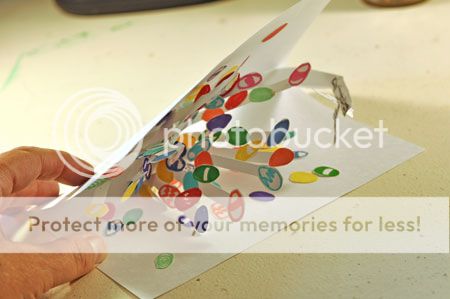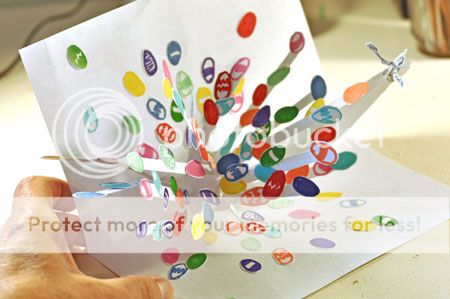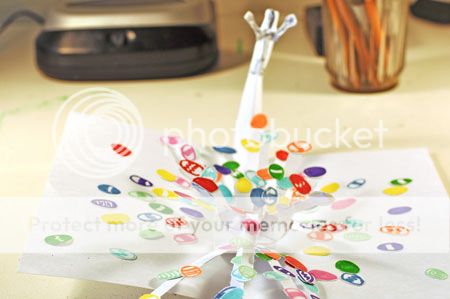It's going to be Valentine's day in, what, a couple of days. You cannot buy a card so precious as one that you make. Because you put your heart into the effort, and it shows, and that's what the day is all about. It's a made up holiday anyway to compel you into buying something to compensate for your lack of imagination but you can use that and take advantage of the opportunity to express your genuine affection. You don't have to be in love. You just need to want some attention.
It's an attention-getting thing. Totally self-serving.
You have time enough to make a delightful and imaginative card. One that will become a keepsake.
This is Duncan Birmingham, author of pop-up tutorial books, graciously sharing his hard-earned card-related wisdom. He demonstrates what he calls an "M-fold." It could just as easily be called a "W-fold." It is a fan fitted with tabs to attach to both sides of a card. The creases of the fan have scissor snip cuts to push out the paper in the opposite direction to invert the creases in spots. These creases and multiple inversions allow increased surface directions to attach content. For greater chaos. This fan is the base for content.
What is your content?
That's easy. It's already shown to you on millions of Valentine's Day cards. Hearts. With little paper slips to extend the hearts off the M-fold fan mechanism. Like hearts on sticks. Attached to creases of the fan going in all directions. Flying all around chaotically in all directions. Utterly random and unplanned. But the way it opens to chaos and folds back to a neat package gives the appearance that you planned all that in advance, when you didn't, you just slopped your way through the whole thing.
All you did was check each random addition to make sure it fits inside when the card is closed.
You can put creases into paper like a fan, can't you? You can cut out heart shapes, can't you? You can certainly cut slips of paper like flat little 2x4 boards, can't you? You can glue things like a kindergartner. Therefore you can do this easily. QED.
Stop! I'm not having any excuses. Just watch how simple this is.
That was easy as eating pie.
This too is easy but it fools you by seeming advanced. Odd that it's Birmingham's final YouTube tutorial. That's because it incorporates a doubling of a basic V concept in opposition, then cleverly unites those two V mechanism into one simple piece of paper, and further connects the two origami Vs at opposite corners. That creates two new planes of surface area to attach content. You end up with all this surface area of planes in different directions that you can attach your artistic content.
Your content can be sensible like the arms and legs of a person that all move outwardly when the card is opened. Or it can be chaotic like hearts extended on slips of paper. Your slips of paper can be arrows if you like. Make one of the hearts a Cupid shooting arrows and all the rest, arrows and hearts strewing all over the place like a tornado. It's actually a mere 90° turn. But 4 of those on separate planes gives a full 360° rotation. And on 6 planes at various angles you get total chaos. And it all twists back into a flat folded card.
You have to imagine his pup tent and the Vs that support it all covered with hearts.
This is actually a children's project.
You have to imagine his pup tent and the Vs that support it all covered with hearts.
This is actually a children's project.
Here is my own representation of this same thing.
It's one piece of paper folded origami style to form two opposing V mechanisms. The non-V bowtie shape is glued to the background card. Mine uses hinges at opposite corners to attach another piece of folded paper that covers the origami mechanism flatly when the card is fully opened.
Notice that Birmingham's example does not go down completely flat when fully opened. His final piece stays the shape of a pup tent. So all his content attached to those two planes will remain suspended in the air at whatever angle he chooses. And having hearts stay stuck in the air looks more chaotic when fully opened.
If you form it to open flatly then all your attached content will also open flatly. Splayed out as if strewn across the whole card.
This gif shows the original idea of two separate opposite V mechanisms, then how that became one-piece origami. It's the natural development of doing this a few times. You go, hey, this could be one piece. Then it shows the hinges on opposite corners, and the final piece attached to the hinges that looks like a pup tent. My example is a fully flattened pup tent.
The artistic content of this example is Easter eggs extended on slips of paper but yours can be hearts. Actually, yours can be anything you desire, like anything you recall from Valentine's Day cards, little Cupids, little animals, cute teddy bears in love, turtles, arrows through hearts, actual bloody human hearts, Egyptian signs for heart, flowers, spaghetti, a car wreck, a light bulb factory explosion, a person spreading their arms and legs, a horse cut to pieces then attached to different planes, gangsters having a shootout with Tommy machine guns for a St. Valentine Day massacre, box of chocolates and roses and Champaign strew all over like the aftermath of a holiday orgy, anything, anything you can draw or cut out, absolutely anything.




No comments:
Post a Comment